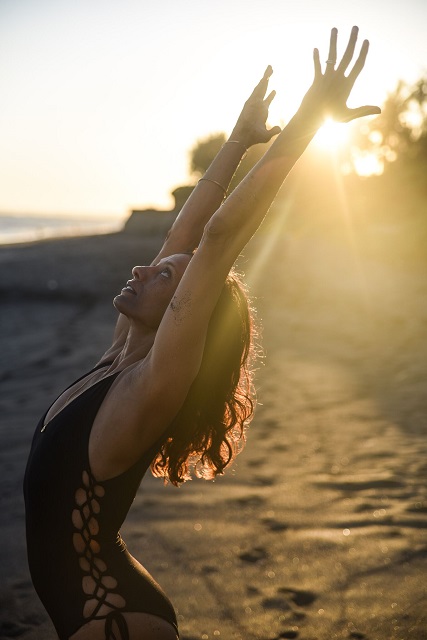
This is the year I turn 40.
It’s a big one for me.
And I’ve been casting a lens at various aspects of my life to see where I am stuck and where I can challenge myself by switching things up, especially if I feel I am in a rut.
So, in an “expand my yoga horizons” experiment, I tested out how I would feel going to a hot yoga studio over this past month.
I did this for a few different reasons:
I wanted to understand this practice that I get my “yoga snob” on about.
I wanted to see if it was really what die-hard devotees make it out to be—as in, “It changed my life!”
I wanted to understand how the heat informs my physical asana practice.
I wanted to see what was out there on different ends of the yoga spectrum in this California coastal town where I have been living for the last few years.
Mostly, however, after returning from a few months of practicing lots of yoga and living in Bali, I was looking for the discipline of attending regular classes versus just doing my practice at home.
I also thought that the heat might be a gentle reminder of the tropical warmth of Bali, and figured classes would be small—after all, isn’t summer the last time one would think of going to hot yoga?
I was wrong on both counts.
Apparently, summer is as popular a time at this particular hot power yoga studio as any other. And the heat was a lot more intense than Bali. There was no early morning or cool evening breeze wafting in from the studio’s windows to cool you off. In fact, there were no windows at all. The temperature in the studio was always at 104 degrees and teachers were told not to leave the doors open, even during Savasana, as the studio wanted a consistent heat. (I asked.)
The classes at this studio were all over the place, ranging from something resembling yoga but really more fitness-oriented—where we did mountain climbers and multiple side planks in the midst of flow practices—to teachers who taught what I would consider a more Vinyasa-style class with alignment and breath cues.
The students also ranged in shape and size, but they all seemed determined, strong, and focused. In Ayurvedic terms, it was all really pitta in nature, and, interestingly, the hot yoga practice exacerbates this pitta nature (like increases like).
This past Friday, I walked into a class that happened to be mostly Ashtanga Vinyasa. I have always loved the Ashtanga primary series and the teacher was focused and clear about her Ashtanga roots. Despite the heat, I could feel myself relax. After all, I thought to myself, this would be a “real” yoga class, not just a fitness experiment masquerading as yoga.
But, while breathing in with the cued ujjayi breath halfway through the class, whenever the teacher said, “breathe deeper,” I began to feel the consistent intensity of the heat. At the same time, I began to watch my mind as I, on the one hand, questioned the validity of this practice in this setting. In fact, I couldn’t help but wonder why a teacher who seemed to have such a pure Ashtanga practice would consider teaching it in such a hot studio. But, on the other hand, I could also observe the mind-over-body part of my brain kicking in with dialogue that urged me to overcome the discomfort—cues you hear so often in the heated power yoga setting. Breathe, I kept telling myself. You can do it.
And it’s a dialogue that, in our fitness obsessed, overcoming pain obsessed culture, we celebrate.
It was a wild experience. I could watch both parts of me trying to battle it out on the yoga mat in that hot yoga studio, following as exactly as I could each cue the teacher offered.
Clearly, I was not crazy to feel what I was feeling.
Let’s get even more specific.
Ashtanga Vinyasa, like most Vinyasa yoga, is an intense, heating/warming practice in a normal temperature room. And, as our traditional yoga teachers taught us, in a Vinyasa practice, you can use the breath, especially the ujjayi—or victorious breath technique—to warm the body up inside out.
When you couple that with external heat, it creates an even more intense situation.
Intensity in Ayurvedic terms is a characteristic of the fire element in us, or the pitta dosha. Too much pitta can create hormonal imbalances, irritability, and excess heat in the body.
Yes, the heat lets you stretch deeper, but is that really the point of yoga?
Yes, you may sweat buckets, but is that really the point of yoga?
And, honestly, you could probably sweat that much if you just went into a sauna or a steam room. At least by doing that, you are not intensifying the sweat by increasing the intensity of your activity in the heat.
I survived that class, as I had survived so many others over the past month.
The warm California evening seemed freezing when I emerged into the light; and I rushed home to get out of my sweat-soaked yoga wear. This was the only reprieve. The shower after. The euphoria that I had survived.
This is how it becomes a habit, I thought to myself. This is what you end up wanting, again and again. Perhaps this is why people keep returning.
But, how do I feel, after my “experiment?”
My big take away is simply this: more is not always a good thing.
This is such a recurring theme in our culture. If we discover that chia seeds are good for us, all of a sudden, we notice 50 different health food products with chia seeds available. If running 30 minutes is good for us, we decide we must run ultra-marathons, potentially in the desert. If a little bit of sweat is detoxifying, of course, we conjecture, a lot of sweat is probably an even better thing.
While Vinyasa yoga in a normal temperature might offer a balanced intensity, amping it up in a super heated room does not offer any benefits, save that of ridding us of most of our water weight and allowing our already intense minds to become even more focused, determined, and fiery. Or, it may simply wipe us out.
Hot yoga may be okay for some people, perhaps in extremely frigid climates—I’m thinking the north of Canada in the winter, maybe?
But, I’m putting this out there as someone who has been studying yoga for more than half my life now and has had the benefit of observing the disconnects and mass marketing of yoga in our wider culture, both in the West and East from different spots in the equation.
My prescription as a yoga teacher and a student of Ayurveda is always to consider the effects of the practice on your body and mind. Do not simply do something because you hear it is healthy or good for you, or because it serves someone else you know.
Rather, practice yoga with Ayurvedic insights by asking yourself:
Is this practice serving me—this unique individual inhabiting this body at this moment in cosmic time?
How do I feel after this particular way of practicing?
Am I wiped out, or can I return to my life feeling stronger and more balanced and more at peace?
Practice yoga because it can help you to balance out the other aspects of your life. If you are an intense, fiery person, don’t choose an intense, fiery practice—choose something that helps you to cool and calm down. On the other hand, if you are super watery in your life, maybe do choose that fiery practice. And always remember that “no pain, no gain” is not always the goal in yoga.
In Blissology, the style of yoga I teach, we are trying to do something a lot more subtle, yet deeper.
We are trying to use our breath in an intelligent manner to open up the body, release stress, and create more peace. And, interestingly enough, when we are less stressed, we don’t hold on to excess weight, excess thoughts, or negativity as readily.
This is where the magic of yoga happens: in the space between.
I know I often love a good, intense physical asana practice, but I’ll practice that way in a normal temperature room again, using my breath as my own personal heater from now on.
Yet, I am always grateful to be able to test out what I see in our wider world, as I never want to comment on anything without experiencing it first.
~
Relephant read:
My Litmus Test for a Good Yoga Class: One Not-So-Simple Question.
Touching the Stove: Yes, Yoga can Hurt!
~
Author: Insiya Rasiwala-Finn
Image: Olivia Nachle
Editor: Khara-Jade Warren
Copy Editor: Nicole Cameron
Social Editor: Sara Kärpänen










Read 15 comments and reply